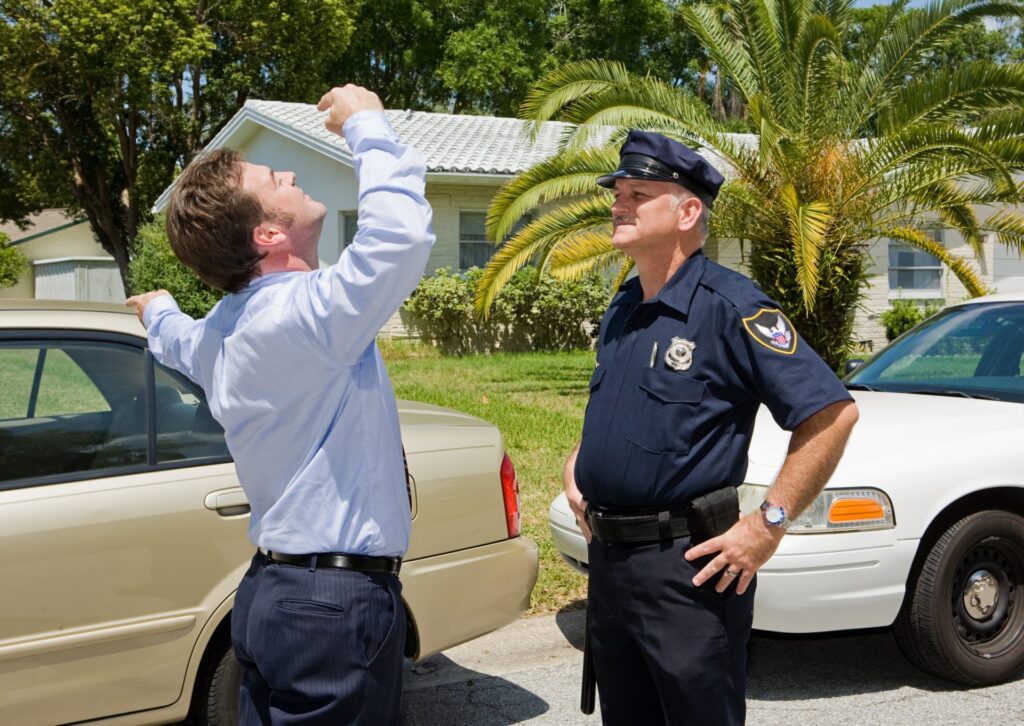When a police officer pulls you over to the side of the road in Portland, you can rest assured that they are already gathering evidence that you committed a crime. Frequently, by the time the traffic stop has been initiated, the officer already has enough evidence to write a ticket – they’re just looking for evidence of a more serious offense. In fact, police are not supposed to be able to make a traffic stop at all until they have reasonable articulable suspicion to believe that a crime (or traffic infraction) is being committed or has been committed, already.
With this in mind, here is what you need to know about the One Leg Stand, a staple of the field sobriety tests conducted in Maine.
Field Sobriety Tests and OUI Law in Maine
Field sobriety tests are a common way for police to gather evidence that you have been drinking or that you are under the influence of drugs. Performing poorly on a field sobriety test gives police valuable evidence that you are operating under the influence (OUI) and are committing a crime. Performing well on a field sobriety test, on the other hand, does not guarantee that the police officer will let you go on your way. In fact, there are numerous OUI cases in the Portland area where a police officer pulled someone over and ran field sobriety test after field sobriety test in the hope that the driver would fail one of them. When they didn’t fail, the officer arrested them, anyway.
There are a lot of different field sobriety tests that police can choose from. However, most states, including Maine, require police to use only field sobriety tests approved by the National Highway Traffic Safety Administration (NHTSA). The NHTSA approved three tests back in 1981:
- The horizontal gaze nystagmus test
- The one leg stand
- The walk-and-turn
The One Leg Stand
Out of all of the field sobriety tests, the One Leg Stand is the most straightforward: Police will ask OUI suspects to balance on one foot for 30 seconds, holding their other foot about six inches off the ground.
Often, the officer will ask you to count to 30.
In the meantime, the officer is waiting for you to do four things:
- Sway to keep your balance
- Hop to keep your balance
- Using your arms to keep your balance
- Put your raised foot back on the ground before the 30 seconds have passed
If you do any two of these things, you will have failed the One Leg Stand and the officer will arrest you for OUI.
Why the One Leg Stand Can Be Inaccurate
Like all of the field sobriety tests approved by the NHTSA, the One Leg Stand was approved as an effective indicator of inebriation in 1981. Back then, the legal BAC limit was 0.10%, a significant step above the current limit of 0.08%. Questions abound as to whether the One Leg Stand is still an effective tool, or whether it produces too many false positives.
Numerous studies have been done about field sobriety tests. Most are horrifically flawed, only testing young men in ideal testing situations who were without the fear of a criminal conviction if they failed. Even then, the One Leg Stand has only been found to be right an estimated 65% of the time.
But even common sense suggests that the One Leg Stand is prone to error: Some people can hold their balance far better than others. Athletic people are far more likely to pass the One Leg Stand than people who would consider themselves to be uncoordinated. Even the leg you choose to balance on can make a difference – if you are right-hand-dominant, it can be much easier for you to maintain your balance on your right leg than on your left one.
People who are more likely to fail the One Leg Stand than others without being under the influence of anything include:
- Senior citizens
- People who are overweight
- Anyone with prior leg injuries, including to their ankles, knees, or hips
- Anyone with inner ear problems
- People who are tired at the time of the traffic stop
- Anyone who is clumsy or uncoordinated
- Women wearing heels – they are supposed to be able to take the heels off, but then standing on one bare foot is more difficult and can be painful if the test is on gravel
To add another complexity, people can fail the One Leg Stand from nerves and jitters created by the traffic stop and the cars rushing past. Maintaining your balance is easier when you are calm, making a traffic stop far from the ideal conditions for passing the test.
How the One Leg Stand Can Be Manipulated to Create an OUI
Worse, the One Leg Stand can be manipulated by the police officer to create the false positive necessary to make an arrest for OUI. Police have plenty of motivation to do something like this, from padding their arrest statistics to taking their anger out on someone after a long day or a perceived slight during the traffic stop.
One way police can create a failed One Leg Stand is to arrange the test so the OUI suspect is close to passing traffic. When cars come roaring past, it can unnerve the driver and make them lose their balance.
Another way to create a failure is to ask the driver to perform the One Leg Stand on uneven ground or on unsure footing. Many traffic stops happen on the sides of the road or on highway shoulders. These areas are often sloped away from the road and are frequently covered in gravel or grass. Performing the One Leg Stand on unsure footing can make it much more difficult to last the necessary 30 seconds without your balance wavering.
Portland OUI Defense Lawyer William T. Bly
William T. Bly is an OUI-defense lawyer who can help you challenge evidence gathered through field sobriety testing. Contact him online or call his law office in Portland, Maine at (207) 571-8146.


